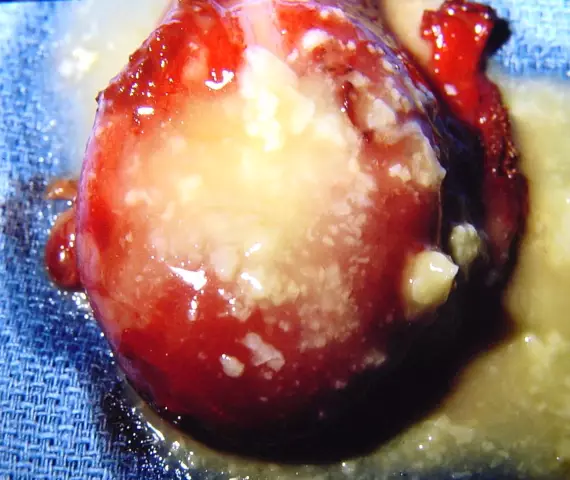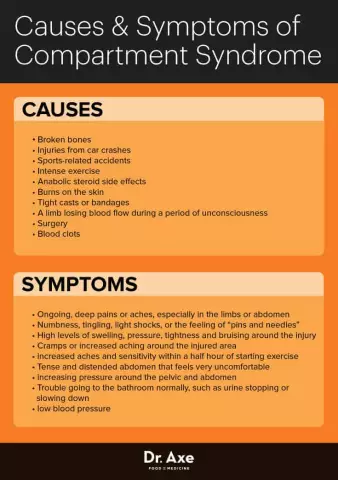- Author Rachel Wainwright [email protected].
- Public 2024-01-15 19:51.
- Last modified 2025-11-02 20:14.
Radicular cyst
The content of the article:
- Development mechanism
- Features:
- The reasons
- Symptoms
- Treatment
- Video
A radicular cyst is a benign cavity formation, the cause of which is the inflammatory process in the periodontium around the tooth. Formed in the area of the apex of the tooth root.

Radicular cyst is a consequence of the inflammatory process in the tooth
Development mechanism
Development begins with the formation of a minor granuloma in the area of the tooth. Then, as the inflammation progresses, collagen and fibroblasts accumulate around the cavity, which are involved in the formation of the capsule. Further, inside the newly formed capsule, the development of epithelial cells occurs. They form the internal component of the cavity (lining it from the inside), which produces a secret and ensures its growth. As the cystic mass grows, it causes local ischemia and atrophy of the bone site.
The process of development of a neoplasm in the jaw region includes several conditional stages:
| Stage | Features: |
| Granuloma | Dense fibrous formation of small size, occurs in the periodontium. It is the primary reaction to the inflammatory process in the tissues (boundary barrier). The only imaging technique is radiography. |
| Cystogranuloma | Occurs as the disease progresses. Symptoms are scanty, often asymptomatic. |
| Cystic neoplasm | The final stage of formation. Has a relationship with the tooth and a characteristic clinical picture. A consultation with a dentist is shown in order to determine the tactics of treatment. |
The process can be stopped at any stage.
Features:
- The cavity is often filled with serous fluid (when a secondary infection is attached, the nature of the exudate changes to purulent).
- It rarely becomes a chronic process. As a rule, this phenomenon is associated with unqualified care (frequent relapses).
- May be asymptomatic for a long time (slow growth).
- Rarely grows into the surrounding tissues and organs (in particular, the radicular cyst of the upper jaw can grow into the maxillary sinuses).
- Radicular cyst of the lower jaw is more common (3: 1).
- It occurs with the same frequency in men and women.
- It is not a tumor.
The reasons
There are several known main causes of this type of neoplasm:
- Inflammatory diseases of the teeth (pulpitis, periodontitis), in which the infection through the canal reaches the root of the tooth, and then goes beyond it.
- Poor quality dental care. In case of improper filling of the canal (incomplete sanitation of the focus of infection), poor-quality restoration (chipped tooth, damage to the gums), the infectious agent can penetrate into the root of the tooth and later into the surrounding tissues.
- Traumatic injury. It is necessary to distinguish between post-traumatic formations caused by a violation of the integrity of the bone structure, and trauma followed by the addition of infection (classic cyst). In the first case, the cystic cavity is filled with an aseptic hemorrhagic fluid and has no signs of suppuration (another nosological form).
- Inflammatory diseases of adjacent organs (stomatitis, gingivitis). In this case, there are some difficulties with differential diagnosis relative to other cystic formations (follicular, gingival cyst), since it is difficult to establish the main etiological factor.
- Disruption of the immune system. In this case, cystic cavities will form due to a low immune response to infection (including opportunistic infection).
Symptoms
With cysts less than 2 cm, the clinical picture is scanty and often a neoplasm can only be detected using radiography.
For radicular cysts of a tooth larger than 2 cm, the following manifestations are characteristic:
- Bulging in the area of the outer wall of the cyst. The direction of the bulging will depend on which tooth is involved in the process (upper premolars and molars - growth towards the maxillary sinus; lateral incisor - growth towards the palatine plate).
- Compression of the neurovascular bundle leads to the development of paresthesias (burning, tingling).
- Deformation of the dentition in the case of growth of the formation towards the pear-shaped opening. In this case, compression of the lower nasal passage and difficulty in breathing, manifested by a feeling of heaviness and nasal congestion. In other cases, visible deformation of the facial part of the skull is less common.
- Thinning of bone tissue and the appearance of crepitus, a symptom of parchment crunch. As the progression progresses, the bone almost completely atrophies, the cystic formation appears through the tissues of the periosteum and mucous membrane, a fluctuation symptom occurs. In advanced cases, pathological bone fractures are possible.
- The pain syndrome is mild, it occurs only when the neoplasm is large and the nerve fibers are severely compressed by it.
- There is a carious tooth above the cystic cavity (typical signs for this particular type of cyst). During its treatment, as you move along the root canal to the apex, a clear yellowish liquid will be released.
When a secondary infection is attached, the cyst turns into a purulent process, which is accompanied by:
- severe intoxication (fever, headache, weakness);
- sharp soreness in the affected area both on palpation and at rest;
- hyperemia and swelling of the gum area at the site of the lesion;
- slight deformation of the dentition (a characteristic symptom for a long process, and not for an acute one).
Radicular cysts of maxillary premolars, molars, and sometimes canines, due to eruption in the maxillary sinus, often cause the development of sinusitis.
Treatment
Surgical treatment:
- Cystectomy is acceptable for any type of radicular cystic formation. The method is distinguished by its radical nature and low risk of relapse, but, given the complete excision of all walls of the cystic formation, it is the most traumatic.
- Cystotomy - used for complicated cystic formations (invasion into the sinuses, destruction of the palatine plate) or in elderly people in order to reduce the load on the body. In this case, the neoplasm is not completely excised, but only the anterior wall is removed, thus ensuring normal drainage of the cavity and smoothing out clinical manifestations. The wound is not sutured, but tamponed and wait for the natural replacement of the bone defect with connective tissue (dressings are required 2 times a week).
- Plastic cystectomy is a combination of these two methods. At the first stage, a cystotomy is performed, and a year later - a cystectomy.
Attention! Photo of shocking content.
Click on the link to view.
With suppurative processes, there are the following features:
- a puncture is performed first to relieve pressure;
- punctured more often along the alveolar ridge;
- no puncture is performed at the site of future surgery (risk of fistula);
- the classical operation is indicated only after the inflammation subsides;
- often a drainage is required for 2-3 days for adequate drainage of the contents.
A brief description of the surgical intervention techniques is presented in the table:
| Operation | Technics |
| Cystectomy | Before removal of the cyst, filling and treatment of the causative tooth (or its removal) is indicated. During the operation, a mucous flap is cut out over the cystic cavity (usually in the form of a trapezoid). All tissues are separated to the jaw bones and trepanation is performed. The cyst is removed with all the membranes and the capsule; if indicated, the apex of the tooth is resected. The cavity that formed after the removal of the formation is thoroughly washed with an antiseptic solution, hemostasis is provided. The wound is sutured tightly. |
| Cystotomy | Before removal of the cyst, filling and treatment of the causative tooth (or its removal) is indicated. The initial stage (up to and including trepanation) is similar to the previous technique. Further, complete exfoliation of the cyst is not performed, but only its front wall is removed. A mucoperiosteal flap, which was cut out at the first stage, and a tampon soaked in an antiseptic solution are placed in the wound. The duration of such treatment varies widely (constant dressings are required to prevent the addition of a secondary infection). |
| Plastic cystectomy | Combined method of treatment (all stages of the two above methods). They are used for severe suppurative processes, when classical treatment causes relapses of the disease. |
| Oronasal cystectomy, oronasal cystotomy | Two types of surgery that are used for sinus involvement. The technique of execution is based on the creation of an outflow of contents along natural pathways (anastomosis of the sinus, cysts and lower nasal passage). The goal is to drain the cavity to start the regeneration process (replacement of the pathological area with connective tissue and self-closing of the anastomosis). |
At the moment, minimally invasive methods of treating radicular cysts (laser exposure) are being developed, but so far they are not widespread.
Video
We offer for viewing a video on the topic of the article.

Anna Kozlova Medical journalist About the author
Education: Rostov State Medical University, specialty "General Medicine".
Found a mistake in the text? Select it and press Ctrl + Enter.






